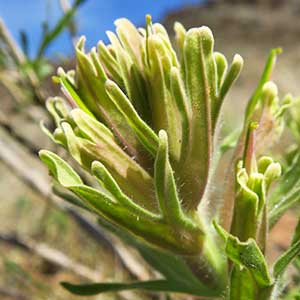Castilleja xanthotricha
Castilleja densiflora
John Day or yellow-hairy paintbrush, John Day paintbrush, yellow hair paintbrush, yellow-hair Indian paintbrush
dense-flower owl's-clover, denseflower Indian paintbrush
few to several, ± decumbent to erect or ascending, unbranched, sometimes with short, leafy axillary shoots, hairs erect to spreading, long, soft, eglandular, mixed with short stipitate-glandular ones.
solitary, erect, branched, sometimes unbranched, glabrous or glabrate proximally, pubescent distally, hairs moderately dense, spreading, short to long, soft, eglandular, often mixed with short stipitate-glandular ones (except var. obispoënsis).
green, linear, lanceolate to broadly lanceolate, oblong, or cuneate, 0.8–5 cm, not fleshy, margins plane to wavy, involute, 0–5-lobed, apex acute, sometimes rounded;
lobes spreading, linear, arising below mid length, nearly as broad as center lobe, apex acute.
pale green, linear to broadly lanceolate, linear-lanceolate, or ovate, 1.4–9 cm, not fleshy, margins plane, flat or slightly involute, (0–)3–5-lobed, apex acuminate;
lobes ascending, linear to narrowly to sometimes broadly lanceolate, apex acuminate to acute.
3–14 × 1.5–4.5 cm;
bracts proximally greenish, rarely dull reddish purple, distally white to cream, rarely pale yellow or dull, pale pink (sharply differentiated from proximal coloration), lanceolate or oblong to narrowly ovate, (3–)5–7-lobed;
lobes ascending, linear to obovate, ± broadened distally, medium, long, proximal lobes arising below mid length, central lobe apex broadly rounded to truncate, others acute to rounded.
1–16(–20) × 2.5–4 cm;
bracts proximally greenish to deep purple, distally white, or pink to pink-purple or reddish purple on apices, if white sometimes aging pink, lanceolate, 3–5-lobed;
lobes ascending, linear to oblanceolate, long, arising below mid length, apex acute to acuminate.
curved, 17–23 mm;
tube 15–19 mm;
beak exserted, adaxially green, 5–8(–9) mm, puberulent, stipitate-glandular;
abaxial lip deep purple (color sometimes visible through calyx), green, pinkish, or pale yellow, ± prominent, slightly inflated, usually hidden in calyx, sometimes right at top of calyx, 2 mm, ca. 50% as long as beak;
teeth ascending, whitish, yellowish, pink, or green, 1–1.5 mm.
straight, 14–29 mm;
tube expanded distally;
abaxial lip and beak exserted from or equal to calyx;
beak straight, adaxially pink, purple, or white, if white often aging light pink, (4–)5–7 mm, densely puberulent, hairs often stipitate-glandular;
abaxial lip proximally white or pink to deep purple, expanded part white throughout, or proximally white or purple, or green becoming light pink with age, distally white or yellow (sometimes becoming orange with age), purple or maroon spots or blotches on each lobe, inflated, lobes 3, pouches gradually (to abruptly) widened, 4–6 mm wide, 2–3 mm deep, deeper than tall, 3–7 mm, 80–100% as long as beak;
teeth erect, pink, white (often turning pink with age), chartreuse, or purple, sometimes with deep purple spot at base, 1–2.5 mm.
colored as bracts, 15–26 mm;
abaxial and adaxial clefts 3.5–7 mm, 25–50% of calyx length, deeper than laterals, lateral 2–5 mm, 12–25% of calyx length;
lobes linear, oblong, or narrowly triangular, center lobe apex usually rounded, lobes acute to rounded.
colored as bracts, 5–20 mm;
abaxial and adaxial clefts 4.7–15 mm, 33–90% of calyx length, slightly deeper than laterals or all 4 clefts subequal, lateral 3–8 mm, 33–60% of calyx length;
lobes linear to narrowly oblanceolate, apex acute.
glabrous.
= 48.
= 24.
Castilleja xanthotricha
Castilleja densiflora
Castilleja xanthotricha is endemic to moderate elevations in the sagebrush hills of the John Day River drainage in north-central Oregon. N. H. Holmgren (1971) hypothesized that this tetraploid species is of allopolyploid hybrid origin between C. glandulifera and C. oresbia.
(Discussion copyrighted by Flora of North America; reprinted with permission.)
Varieties 3 (3 in the flora).
Castilleja densiflora is often confused with C. exserta, and both species are broadly overlapping in both range and habitat, often occurring in close proximity. However, intermediates are remarkably rare. The two are most easily separated by the structure and pubescence of the corollas. In addition to the characters mentioned in the key, C. densiflora usually has a bilobed stigma that is exserted from the apex of the corolla with a more or less vertical orientation, while that of C. exserta emerges horizontally and is capitate. These differences are remarkably consistent.
(Discussion copyrighted by Flora of North America; reprinted with permission.)
1. Bracts distally white, rarely pale yellow; coastal grasslands; San Luis Obispo County, sc California. | var. obispoënsis |
1. Bracts distally pink to pink-purple to red-purple, rarely white; near-coastal and interior grasslands; widespread in w California. | → 2 |
2. Abaxial lips of corollas appearing slightly inflated, pouches widening gradually, longer than deep, 3–7 mm; calyces 8–20 mm. | var. densiflora |
2. Abaxial lips of corollas appearing moderately inflated, pouches widening abruptly, deeper than long, 4–5 mm; calyces 5–11 mm. | var. gracilis |


